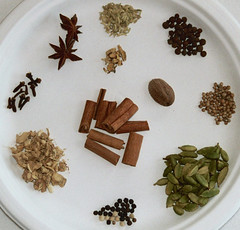I don’t know if you all have figured it out yet, but we buy whole spices.
Other people go to the warehouse stores for food … we order from an herb & spice importer. Not only do we get a tremendous discount over what we’d pay at the supermarket, we get fresher, higher quality herbs & spices. We also get forced into using a whole lot more herbs & spices, because, really, who can afford not to use them in profligate amounts when they’re taking up cabinet space?
I’d finally run out of brown mustard seed (it took me about a year), so I ordered two pounds this time. It’s truly irritating to run low on such a staple. Yes – mustard seeds are a staple, because they go in just about every batch of sourdough bread, to the tune of about 4 Tablespoons. Same with yellow mustard. The caraway seeds are by way of experimenting, as are the celery seeds and psyllium husks (we’re going to try to incorporate those into protein bars, so that they’re not so … slow in the system).
All this is, of course, by way of sharing the sheer quantities of spice we buy, and because I was told that our recipe for scones was intimidating in its sheer number of ingredients. When you’ve got a pound of whole cloves, a pound of star anise, a pound of fennel seed, and 1-pound bags of just about every other spice which might go into a recipe? Well, you use them! And you get familiar with them! And you learn how to balance them against one another, and you experiment more with them, and cooking becomes much more fun.
Now, to reorganize the cabinets, because we’re out of room. And out of spice cannisters. Sigh.






 The Alaska Daily News carried a piece on
The Alaska Daily News carried a piece on 












